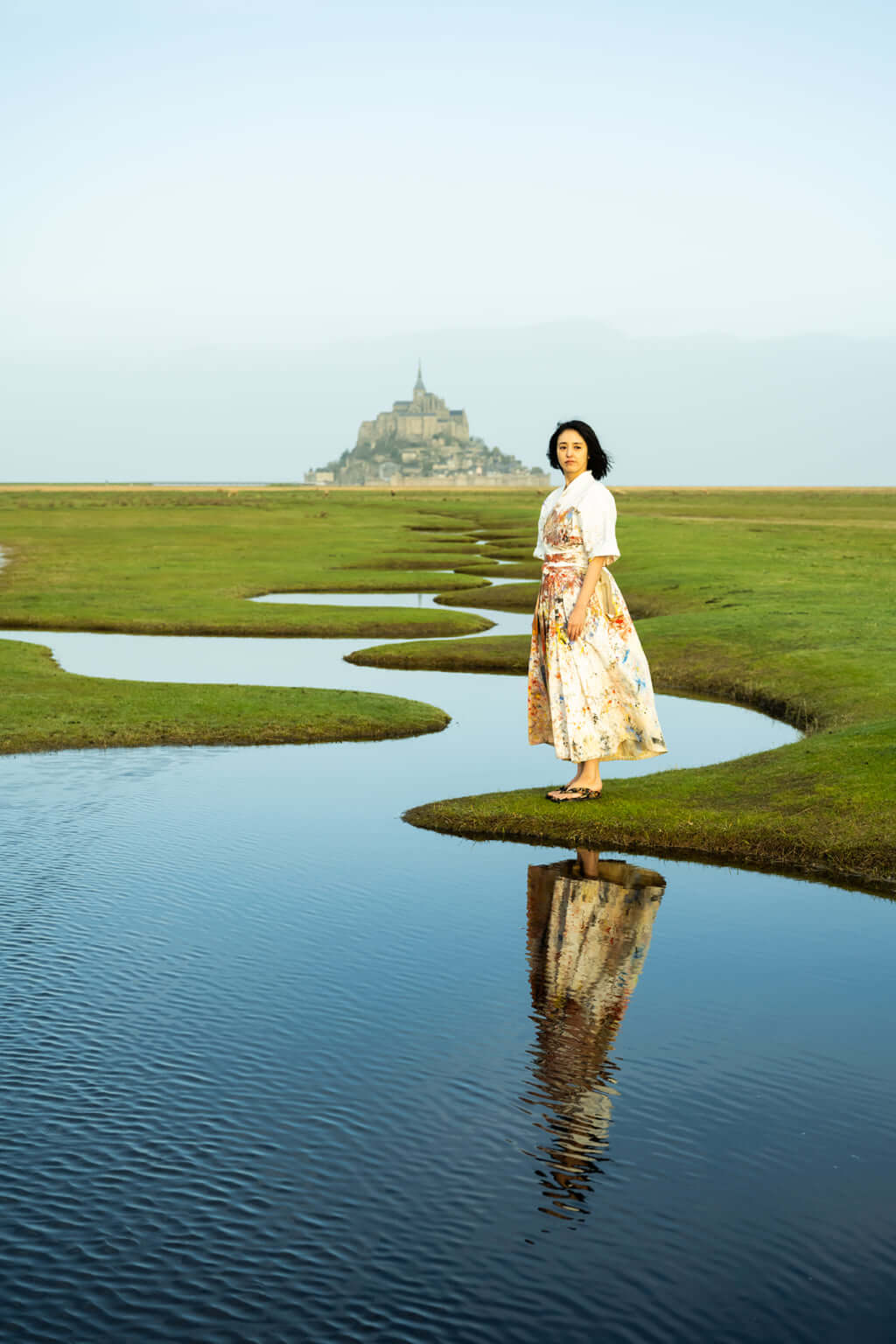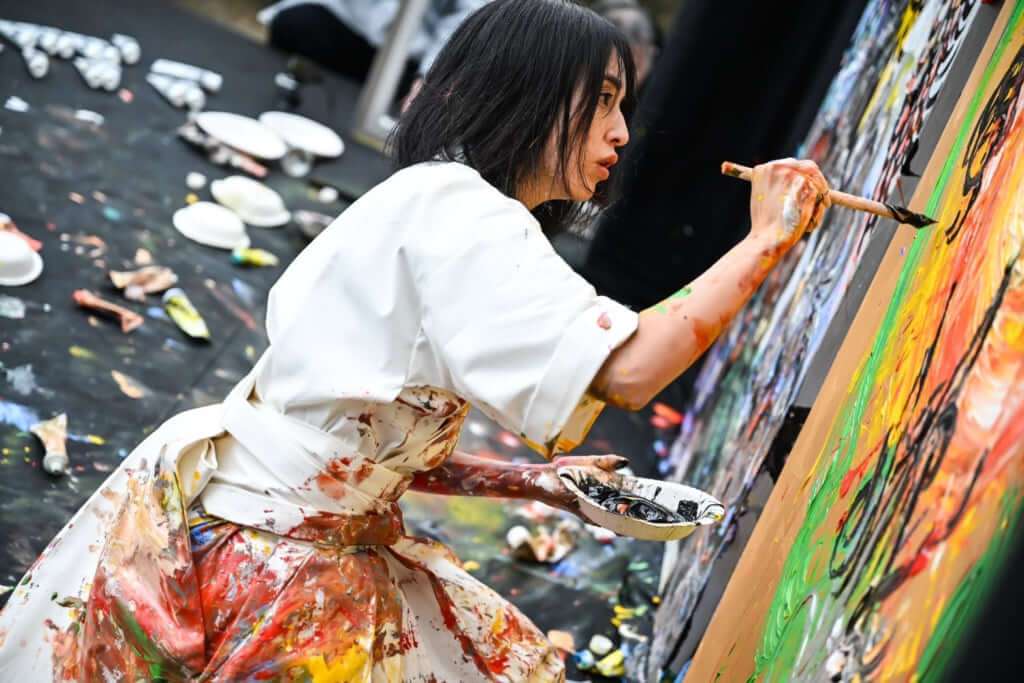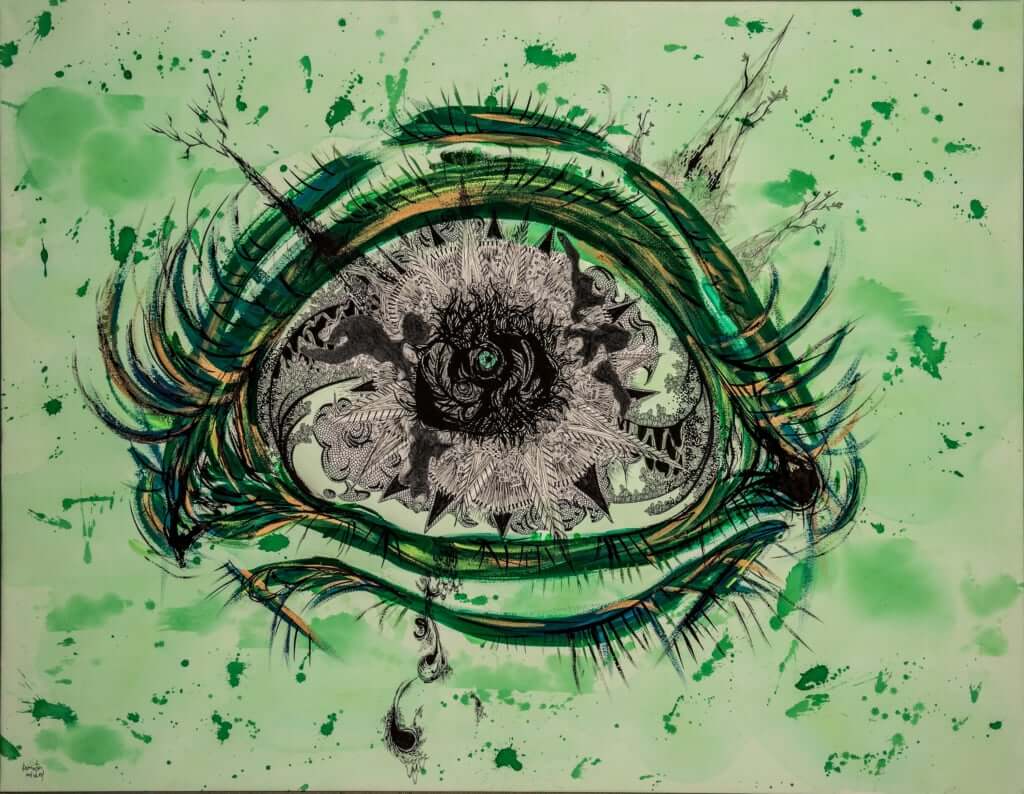Miwa Komatsu, Art in a State of Meditation
The artist, a proponent of live painting, draws inspiration for her deeply spiritual works from her rural origins.

Miwa Komatsu standing in front of Mont Saint-Michel © Tatsuya Azuma
The bright colours gush onto the canvas, applied straight from the tube of paint, before the artist spreads them out, works them and transforms them using her hands or a brush. Miwa Komatsu‘s movements are steady and precise, and yet everything was spontaneous and improvised in this live painting session that took place in November 2023, with Mont Saint-Michel as the backdrop.
The painter hails from the mountainous region of Nagano, and grew up in communion with nature. This environment acts as her main source of inspiration for her art inhabited by the invisible. Her favourite techniques include painting and sculpture. Her work, now world-renowned, has been featured in the permanent collections at the Nagano Prefectural Art Museum, the British Museum and the World Trade Center, among others.
Colourful artwork with powerful brushstrokes
In her artwork, Miwa Komatsu depicts ‘divine spirits’ and mythological creatures. When she was a little girl, she claims that she met ‘Yamainu-san’, a deity that looked like a wolf, who encouraged her to paint. The artist seems particularly fond of komainu, the statues of lion-dogs often found at the entrance to temples and shrines in Japan, where they act as guards.
Her artistic approach is guided by the concept of ‘Great Harmonisation’, an idea that opposes that of ‘Great Acceleration’ often used to refer to the 20th century, a period marked by an acceleration in scientific and technological progress and communications. For Miwa Komatsu, the ‘Great Harmonisation’ involves bringing together various elements on her canvas until they form a coherent whole, much like a mandala. She wishes to see this harmonisation become a reality across human societies, nature and space. Her piece ‘NEXT MANDALA – Home of Soul’ created at Mount Koya in 2021 is emblematic of this intention.
Thus, Miwa Komatsu views art as a sacred ritual. ‘Art is a form of meditation for me’, she explains in an interview with Pen. ‘I enter a deep spiritual state that allows me to pass through different universes and dimensions before painting their teachings on the canvas.’ To do this, it is necessary to reach a certain state of awakening. As a result, the artist decided to move back to her native region and set up her studio there, to get away from distractions and devote herself fully to her practice in almost ascetic conditions.
Over the course of her journey, peppered with spiritual experiences, her art has become more refined and less figurative. However, the power of her brushstrokes, the dynamic nature of her compositions and the brilliance of her colour choices remain. Thus, in 2013, after embarking on a pilgrimage to the Izumo Grand Shrine, one of the most important Shinto shrines, Miwa Komatsu decided to incorporate colour in her previously monochrome works. While there, she saw rainbow-coloured rays of light rise up to the sky, symbolising the prayers of the many worshippers who gathered there.
Art is like a prayer
‘To me, creating is a gift from the heavens’, the artist continues. ‘It isn’t about my ego, my hands come alive on their own.’ During her live painting rituals, Miwa Komatsu seeks to interpret the teachings she has received in her own way. Her approach to art as being like a prayer has seen her perform live painting rituals in sacred places, such as Izumo-taisha and the Itsukushima shrine (on the island of Miyajima in Hiroshima prefecture), which has been twinned with Mont Saint-Michel since 2009. During a session that took place on the island in Normandy in 2023, the artist painted in an abbey for the first time.
Miwa Komatsu makes sure to study the history of the region she is visiting beforehand, so she can show it her respect and appreciation. Indeed, her live painting rituals always begin with a prayer of gratitude. The artist dresses in a white hakama, marking a solemn moment. She equips herself in advance with a sufficient number of tubes of colourful acrylic paint, which she will dip into throughout the ritual. Then the creative trance can begin.
In Mont Saint-Michel, Miwa Komatsu painted two pieces that became votive offerings. The first, ‘Prayer for peace’, depicts two imposing dragons, and is dedicated to Hatsukaichi, the city that has jurisdiction over the Itsukushima shrine. The second, ‘Prayer of compassion’, features angels, and is dedicated to the commune of Mont Saint-Michel. In the future, Miwa Komatsu wishes to continue her spiritual journey and hopes to have the opportunity to perform other live painting rituals overseas, perhaps in Israel.
More information about Miwa Komatsu’s work can be found on the artist’s website.

© Tatsuya Azuma

© Tatsuya Azuma

Miwa Komatsu sitting in front of ‘Prayer for peace’ (left) and ‘Prayer of compassion’ (right) © Tatsuya Azuma

‘THE NEXT MANDALA - Home of Soul’, 2021

‘Yamainu-sama - Protection’, 2018

‘Speak No Evil - Yamainu’, 2022

‘Did You Feel The Vibration Filling Your Soul?’, 2014

TRENDING
-
Ishiuchi Miyako, A Singular Perspective on Women
Recipient of the 2024 Women in Motion Award, the photographer creates intimate portraits of women through the objects they left behind.

-
Recipe for Ichiraku Ramen from ‘Naruto’ by Danielle Baghernejad
Taken from the popular manga with the character of the same name who loves ramen, this dish is named after the hero's favourite restaurant.

-
Namio Harukawa, Master of Japanese SM Art
'Garden of Domina' offers a dive into the world of an icon of ‘oshiri’, whose work has now reached a global audience.

-
The Tattoos that Marked the Criminals of the Edo Period
Traditional tattoos were strong signifiers; murderers had head tattoos, while theft might result in an arm tattoo.

-
The Emperor of Japanese Porn is Now the Star of a Netflix Series
Deliciously funny, The Naked Director especially succeeds in reviving the atmosphere that was so characteristic of 1980s Japan.





